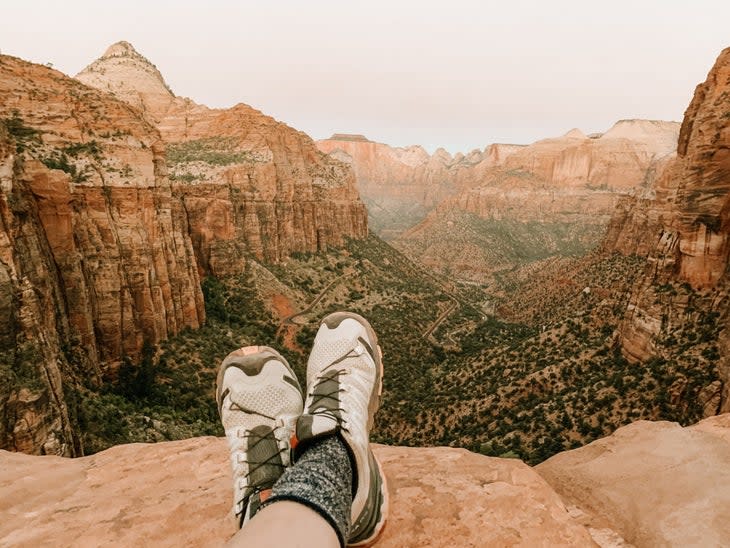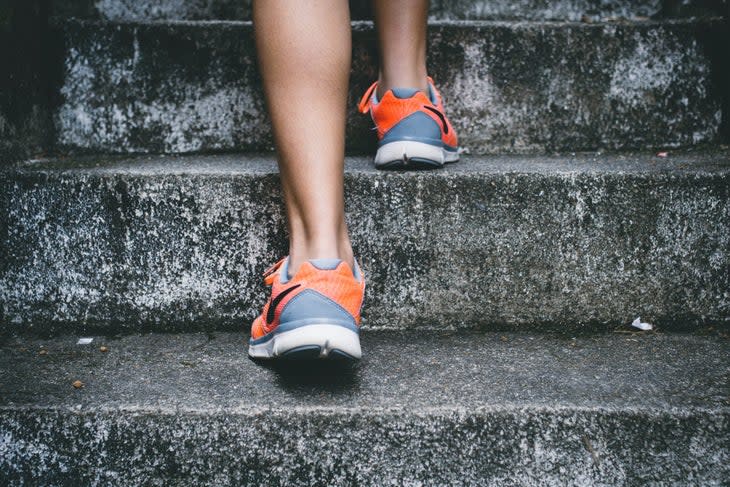How to Pick the Right Running Shoe
This article originally appeared on Trail Runner
I remember walking out of a running store in the summer of 1990 with a pair of chunky, stiff, controlling Nikes and the words of the store salesman ringing in my ears: "You need these shoes and you need them now." The shoe fitter had observed my gait on a treadmill, analyzed my training and injury history, and determined which models would enable me to run properly and avoid future injury. It didn't matter much whether I liked them or felt comfortable in them (I didn't, on both counts), I accepted the diagnosis and dutifully ran in them until it was time to get a new prescription.
While not every shoe fitter of the day was as dogmatic as my confident clerk, he reflected the long-accepted belief of the running industry that shoes were essentially medical devices. Throughout much of the history of running shoes, they have been largely designed, marketed, reviewed, and sold for their ability to prevent injury.
Today, however, the industry is gradually overturning the assumption that shoes are going to fix and protect runners. Brands are now creating shoes that promise to enhance running performance and experience, and runners, rather than being prescribed the models they need, are encouraged to choose the ones they like--shoes that make them feel comfortable, fast, and happy.
The Pronation Paradigm
The idea of running shoes as injury-prevention devices dates back to the beginning of the modern running movement. The 1972 Nike Cortez (of Forrest Gump fame), the first running shoe designed for the masses, included a cushioned midsole, a new feature said to minimize impact stress, and a raised heel, purported to reduce strain on the Achilles tendon. Within a few years, the industry blossomed with hundreds of new models boasting cushioning and support designed to reduce injury. In 1980, biomechanist Peter Cavanaugh compared running shoes to prescription drugs in The Running Shoe Book, and laid out a 23-point checklist for diagnosing what injury-reducing features runners should look for to select the right shoe for their specific needs.
RELATED: The Best Trail Running Gear of 2022
In the early eighties, brands went even further, introducing firmer posts and wedges into the arch side of midsoles to correct overpronation, the excessive inward rolling of the foot that was widely blamed for a myriad of injuries. Diagnosing one's level of pronation quickly became a primary preoccupation for runners. Magazines recommended doing "wet tests" to reveal your arch height and correlated pronation level. Shoe fitters performed gait analyses and diagnosed runners as neutral (free to choose any shoes), moderate over-pronators (limited to the stability rack), or severe over-pronators (damned to wear heavy, stiff motion-control models). These categories became universally adopted by brands, stores, and guides, and this pronation paradigm would persist for more than two decades.

The first rumblings of change began in the early 2000s, when research revealed a lack of proven links between actual injury rates and the two main characteristics of running shoes: cushioning and stability. Instead, scientists suggested that running is natural and that our bodies need no additional support or correction. Throughout the decade, the rumblings became a movement that verged on religion, with the bestselling 2009 book, Born to Run as its Bible. But while the faithful rejected overbuilt shoes--or shoes at all for some--they clung to the belief that the right footwear would keep runners healthy. Instead of cushioning and control models, however, they promoted designs that provided ground feel and let feet move naturally as the key to injury-free running. But when the new minimalist models failed to solve all ills, and instead led to new injuries, the movement collapsed as quickly as it had risen.
Disillusioned, many returned to the old categories (in truth, about 85 percent of runners continued to buy stability and cushioned models even during the height of the minimalist craze). Brands continued to churn out their tried and true, high-selling models like the Brooks Adrenaline and Asics Kayano, reviews still called out protective shoe features, and specialty stores tried to assess which ones runners needed.
Comfort Over Correction
But the status quo had been shaken. New brands that had emerged in the great disruption of minimalism were creating models that were hard to fit into the old boxes: Hokas, with thick, cushioned soles that rocked rather than flexed; Altras, with wide toe boxes and low heels but ample cushioning; Ons, with compression pods on their soles. Established brands had to innovate to compete, and they did. Adidas developed Boost foam, which promised more energy return and blurred the distinction between cushioned and performance shoes. Brooks, long known for their stability shoes, began phasing out motion-control posts in lieu of less-intrusive, more versatile guide rails. Across the industry, shoe uppers evolved with stretchy knits that held the foot while allowing natural movements.
Meanwhile, experts, from biomechanists to physical therapists to podiatrists, increasingly pointed out that our faith in shoes and the diagnosis process was flawed. Not only do shoes fail to control foot movement, they said, but pronation is normal, and no one can pinpoint exactly where it becomes excessive for any one runner. Foot strike and stride mechanics also vary naturally based on individual body characteristics, and it is highly difficult to identify any aspects needing intervention. "You could take ten physical therapists, ten podiatrists, and ten rehab doctors and have them look at a runner on a treadmill and you'll get thirty different descriptions of what they see and the significance of what they see," says Paul Langer, former president of the American Academy of Podiatric Sports Medicine. How could runners expect to trust a running store salesman to diagnose their needs, no matter how experienced?
RELATED: How Long Do Running Shoes Actually Last?
In 2015, Benno Nigg, a professor at the University of Calgary and one of the world's leading biomechanics researchers, made the radical proposal that the most effective way to choose shoes was what he called the "comfort filter." His lifetime of research had failed to validate the old methods of prescribing footwear, and new studies had shown that runners who selected shoes or inserts they found most comfortable had fewer injuries and ran more efficiently.
Nigg's concept of comfort went beyond fit and step-in feel that runners had always assessed. It asked instead whether the shoe complements how each runner's body moves and interacts with the ground. "You shouldn't just slip into the shoe and say, 'That's nice,'" Nigg says. "You should take them out and run around a little bit."
In Nigg's model, the most comfortable shoe disappears on the run: you touch down where you expect to land and transition smoothly and stably onto the platform, your foot moves the way it wants to through the stride, you feel both connected to and cushioned from the ground, you roll off the toe quickly and naturally. Nigg admits that comfort is rather subjective, but it's more effective than diagnosing based on faulty assumptions and assessment methods.

"We can't prescribe footwear," says Simon Bartold, biomechanist and shoe design consultant. "We're getting away from people trying to do gait analysis on runners. We're trying more to understand the interaction of the shoe and the foot rather than worry about, 'Are you pronating,' 'Are you supinating, 'How much cushioning do you need.' I think we've moved past those sorts of things."
While runners were getting used to valuing comfort over correction, another bombshell radically altered how we view running shoes. In 2016 Nike introduced the VaporFly 4% which claimed to improve running economy by its namesake four percent. Studies and falling records proved the claims true: these super shoes, and their cousins soon created by every brand, can help you run faster with less effort. Running shoes were suddenly fulfilling a childhood fantasy: magic shoes that let us fly, or at least transform us into better athletes.
Today, as materials and designs from super shoes trickle down into all new models, so has the promise that shoes can enhance your performance and experience. Whether you're looking for a top-of-the-line racer to propel a marathon PR or an entry-level model to help stay with a couch to 5K program, there's an expectation that the shoe can make your run more enjoyable, and that is promise enough.
Marketers, shoe reviewers, specialty retailers, even podiatrists are increasingly letting go of the long-held idea that a shoe has to fix things. "We're beyond that curve, we're shifting to performance comfort as a primary focus in the industry as a whole," says Justin Craig, owner of RUNdetroit specialty store.
Runners still blame injuries on shoes, and too often believe that the right model will cure their aching knees or feet. But evidence remains scant that any element of a shoe can prevent or cure injury. And, even if they can, we don't know enough to be able to prescribe the right ingredients.
"There are so many questions we cannot answer yet, it is hard to give a specific answer to one specific runner," says Laurent Malisoux, researcher at the Luxembourg Institute of Health and today's leading expert on running shoes and injury. If a runner were to ask him what kind of shoes to wear, Malisoux says, "I wouldn't dare give any advice, it is so individual." Instead, he says he'd ask, "What shoe do you use? Do you like it?" And his recommendation? "If you like it, keep it, if you don't like it, change it. And that's it."
In this brave new world, it's enough for running shoes to make you happy. "If we can make it feel a little bit easier or more enjoyable, we can take away one more barrier to running," Craig says. "There's an excitement in putting on a shoe that feels bouncy, that energizes your run. It puts a smile on your face. Even if you're just doing your Wednesday night jog around the neighborhood--pull out your fast shoe. You don't have to go fast, but if you feel fast, that's a win."
This story originally appeared on Outside Online.
For exclusive access to all of our fitness, gear, adventure, and travel stories, plus discounts on trips, events, and gear, sign up for Outside+ today.

